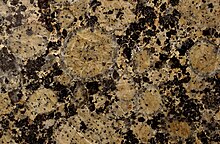Rapakiwi

As rapakivi granite or earlier than Murkstein refers Granite with unequally large granular and up to several centimeters, round phenocrysts (ovoids) of feldspar and a relatively fine-grained matrix of quartz , various feldspars and Mafic minerals .
term
The name ( Finnish : rapakivi " crumbling stone" or "bad stone") is derived from the conspicuous form of weathering of the minerals, which mainly takes place near the surface. The rock breaks down into sharp-edged rubble on the surface. Solid stone and gravel lie next to each other on a small scale. Jakob Johannes Sederholm translated this term, which is common in southern Finland, in 1891 as "lazy stone".
The name was first mentioned by U. Jerne and dates back to 1694. Daniel Tilas (1739), Böthlingk (1840), Thomas von Ungern-Sternberg (Leipzig 1882, dissertation) and Jakob Johannes Sederholm (1891) took up the term . The latter published his description in Tschermak’s Mineralogical and Petrographic Notes of the year mentioned. From this geologist comes the first scientific description of this rock group according to modern understanding.
Petrography, typology
In addition to the large ovoids, the small crystals of the ground mass are hardly noticeable. But they can still be seen with the naked eye. The base material has a special structure that is similar to writing granite and is called myrmekite , even if it has a different origin. Small quartz crystals have grown through the larger feldspar crystals. In cross-section, this pattern resembles ancient characters. Furthermore, the ovaries often, but not always, have a border of plagioclase (e.g. green oligoclase ).
With the Rapakiwigranites two basic manifestations are distinguished according to the occurring crystalline structure. Both types have a porphyry structure in common, which shows large single crystals in a significantly smaller-grain matrix. It is characteristic of both variants that they have small drusen spaces. This feature is known as miarolitic cavities .
Vyborgite

The Rapakiwitypus Wyborgit (also: Wiborgit ) has coarse-grained alkali feldspar sparrows ( orthoclase or microcline ), which are surrounded by one or, more rarely, several parallel lines of oligoclase. Therefore, the overall picture is reminiscent of balls. Some feldspar sprouts are grown together and have a common seam. The fine-grained matrix consists of quartz, biotite , hornblende and plagioclase.
The name of this Rapakiwi variant is derived from the Vyborg massif , part of the Russian-Finnish Karelia landscape in the vicinity of the city of Vyborg and goes back to the geologist Walter Wahl (1925).
Pyterlite

The Rapakiwitypus Pyterlit also has large alkali feldspar crystals. These do not have an oligoclase fringe. The proportion of quartz is slightly higher than that of vyborgite.
The name is derived from the type locality Pyterlahti with its old quarries near Virolahti and was also coined in 1925 by Walter Wahl.
distribution
Rapakiwigranites are found worldwide, but mainly occur on geologically ancient, continental crusts from the Precambrian . The main European distribution area is in Scandinavia , especially in Finland . The four Finnish Rapaki regions are the Åland Islands , the region around Vyborg (partly belonging to Russia), Nystad and Pitkjaranta . Of particular importance is the Vyborg Massif, a Middle Proterozoic batholith that was studied by Finnish and Russian scientists.
But there are also Rapakiwi rocks in the coastal area of northeastern Sweden (near Rödö), in southern Norway ( Drammen ) and Russia ( Salminski massif and Uljalegski massif in South Karelia ), in the southern Urals and on the southwest coast of Lake Baikal . Rapakiwis are also known from the Korean Peninsula and Ukraine .
In the Baltic region and in northern Central Europe, Rapakiwigranites are very common as glacial debris . While they usually come from Finland in the Baltic States, most Rapakiwi sediments in Central Europe can be traced back to the Åland Islands.

Rapakiwis as natural stone
These stones have been used as natural stone for decades under the names Baltik Braun (or also brown ), Baltik Rot (or red ), Carelian red and Carmen red . These are stones that are widespread in Europe for facades, floors, decorative objects and tombs. These natural stones are frost-resistant and can be polished.
Rocks of this kind are traditionally found in the architecture of southern Finnish cities and in the Saint Petersburg region. In German-speaking countries, they are often used as facade panels and flooring.
The name designation as Murgstein or rotten stone etc. says nothing about the current technical use of the Rapakiwis in natural stone processing . The superficial weathered layers are not used for stone . The technical and other values of the Rapakiwis, which are important for their use in construction, are quite comparable with other granites.
literature
- FY Loewinson-Lessing , EA Struve: Petrografičeskij slovar ' . Leningrad, Moskva 1937
- Friedrich Müller : INSK compact . Pages 19.3, 19.4, 24.2 Ulm (Ebner Verl.)
- JJ Sederholm : About the Finnish Rapakiwig stones . In: Tschermak's Mineralogischen und Petrographischen Mittheilungen, NF, 12th vol., Vienna (Alfred Hölder) 1891
- Wolfhard Wimmenauer: Petrography of igneous and metamorphic rocks . Stuttgart (Enke) 1985 ISBN 3-432-94671-6
Individual evidence
- ↑ F. Y. Loewinson-Lessing, E. A. Struve, 1937, p. 286
- ↑ J. J. Sederholm: Rapakiwigesteine 1891, pp. 1-31
- ↑ FY Loewinson-Lessing, EA Struve, 1937, p. 64
- ↑ Wolfhard Wimmenauer : Petrographie , 1985, pp. 70-71
- ^ FY Loewinson-Lessing, EA Struve, 1937, p. 254
- ↑ JJ Sederholm: Rapakiwigesteine 1891, p. 24
- ^ Walter Wahl: The rocks of the Wiborg Rapakiwig region . Fennia, Volume 45/20, Helsingfors (Tilgmann) 1925, p. 6
- ↑ М. С. Зискинд: Декоративно-облицовочные камни . Ленинград (Недра) 1989, стр. 18-25
